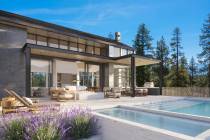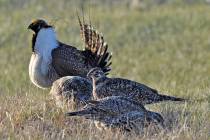Reduce home cooling costs with plants
Landscaping with energy efficiency in mind is not a new idea. In the early days of Las Vegas, Helen J. Stewart and others used cottonwood and mesquite trees to modify temperatures around their homes. Today, many of us head for the mountains to cool off.
Beat the heat by planting trees to shade the roof, walls and windows of your home. Shading even 20 percent of the roof for an entire day will reduce your energy costs.
Researchers in Arizona found shade trees next to homes reduced cooling costs by 17 percent. When trees cast dense shade on all sides of the home, they reduced yearly cooling costs by 46 percent. That makes a lot of “cents” to me!
Trees also give your home curb appeal, according to the American Nursery and Landscape Association.
For years, we’ve concentrated on making landscapes more water-efficient, but with energy costs rising we now need to give more thought to energy-efficient landscapes. Here are ways to take advantage of plants around your abode.
You need to subdue the effect of the summer sun. Today, at noon, the sun is almost directly overhead building heat on your home’s east and west walls and roof. Focus your resources on landscaping these exposures for maximum energy savings. Do it by planting tall, high-crowned trees such as palms close to the home.
Next, shade south-facing walls and windows with trellises. Angle slats to block summer sun and permit winter sun to penetrate through. For added savings, cover trellises with vines such as cat’s claw to shade and cool the surroundings. It thrives in heat and little moisture.
On the east side, plant bushes or low-growing trees such as mesquites and desert willows. They have light foliage that hinders early morning heat buildup but permits refreshing air of the new day to filter through.
Now, the heart of the problem, it is the west side where you really need protection from the torrid afternoon sun. Use low trees with dense foliage or thick bushes to retard the sun’s rays. Western exposures also are vulnerable to harsh glare, but greenery absorbs it.
You can almost forget about the north side of the house; the sun rarely bothers this area. However, bushes block unwanted sun hitting the house just before sunset and deflects winds during the summer and winter.
Extensive hard surfaces, such as concrete, absorb heat that persists well into the night if not checked. I recall measuring temperatures of 164 degrees under rock mulches one hot summer day. This heat remains after dark, making it very uncomfortable during evenings. Plant wide-spreading trees that extend out over the patio to reduce the heat so it won’t intensify within the home.
Shade air conditioning units on the ground. This improves their performance, but place plants so they don’t block airflow to the units.
We tend to overlook shrubs as air conditioners. They cool the area while transpiring. They establish themselves quickly, are less expensive, require less space and their roots and overhanging branches seldom harm utilities, foundations and roofs.
Ground covers are unsung heroes. They not only cool the surroundings but soften glare off the soil by reflecting it before it reaches you. Use these workhorses on large surfaces such as patios, walkways and bare soil.
Finally, shrubs and trees can have a marked effect on the way air flows near your home. Place shrubs perpendicular to the prevailing winds to protect your home from those hot and cold wind blasts.
PICK YOUR OWN FRUIT
If your taste buds desire plums, apricots, peaches, tomatoes, cucumbers and zucchinis, then go to the Gilcrease Orchard to pick your own produce. It is at 7800 Tenaya Way in the northwest part of the valley. On Tuesdays, Thursdays and Saturdays from 7 a.m. to noon, you can pick your own. There is a charge for what you harvest. It was the desire of the late Ted Gilcrease to provide families a place to bring children to pick their own produce. For more information, call 409-0655.
UNUSUAL SHRUBS ON DISPLAY
Discover the many new varieties of native and cultivated species of shrubs that have been added to the Southern Nevada palette. You’ll discover just how beautiful a water-efficient landscape can be at this free tour at 8:30 a.m. Saturday at the Springs Preserve, 333 S. Valley View Blvd.
Linn Mills writes a garden column each Sunday. You can reach him at linn.mills@springspreserve.org or call him at 822-7754.


















